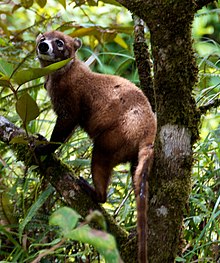White-nosed coati
| White-nosed coati | |
|---|---|
 |
|
| In Costa Rica | |
| Scientific classification | |
| Kingdom: | Animalia |
| Phylum: | Chordata |
| Class: | Mammalia |
| Order: | Carnivora |
| Family: | Procyonidae |
| Genus: | Nasua |
| Species: | N. narica |
| Binomial name | |
|
Nasua narica (Linnaeus, 1766) |
|
| Subspecies | |
|
|
 |
|
| White-nosed coati range. Note: Its Colombian range is more restricted, see text | |
The white-nosed coati (Nasua narica), also known as the coatimundi (/koʊˌɑːtᵻˈmʌndi/), is a species of coati and a member of the family Procyonidae (raccoons and relatives). Local names include pizote, antoon, and tejón. It weighs about 4–6 kg (8.8–13.2 lb). However, males are much larger than females, and small females weigh as little as 2.5 kg (5.5 lb) and large males as much as 12.2 kg (27 lb). On average, the total length is about 110 cm (43 in), about half of that being the tail length.
White-nosed coatis inhabit wooded areas (dry and moist forests) of the Americas. They are found at any altitude from sea level to 3,000 m (9,800 ft), and from as far north as southeastern Arizona and New Mexico, through Mexico and Central America, to far northwestern Colombia (Gulf of Urabá region, near Colombian border with Panama). There has been considerable confusion over its southern range limit, but specimen records from most of Colombia (only exception is far northwest) and Ecuador are all South American coatis.
Coatis from Cozumel Island have been treated as a separate species, the Cozumel Island coati, but the vast majority of recent authorities treat it as a subspecies, N. narica nelsoni, of the white-nosed coati. They are smaller than white-nosed coatis from the adjacent mainland (N. n. yucatanica), but when compared more widely to white-nosed coatis the difference in size is not as clear. The level of other differences also support its status as a subspecies rather than separate species.
...
Wikipedia

